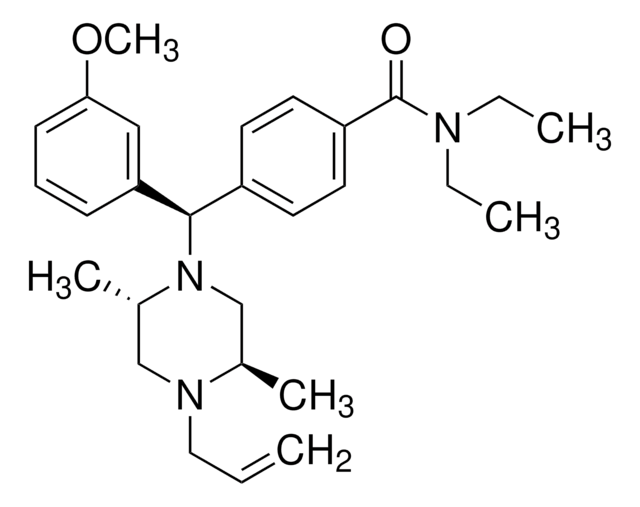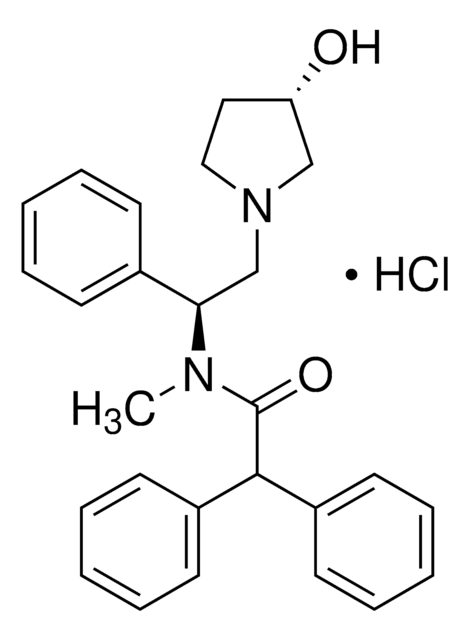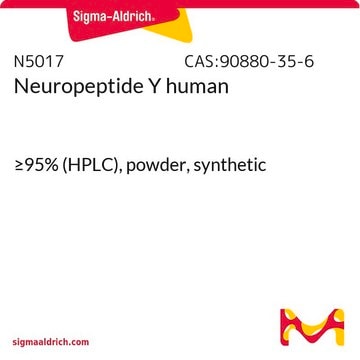SML2046
ARM390
≥98% (HPLC)
Synonym(s):
AR-M 1000390, N,N-Diethyl-4-(phenyl-4-piperidinylidenemethyl)benzamide
Sign Into View Organizational & Contract Pricing
All Photos(1)
About This Item
Empirical Formula (Hill Notation):
C23H28N2O
CAS Number:
Molecular Weight:
348.48
UNSPSC Code:
12352200
NACRES:
NA.77
Recommended Products
Assay
≥98% (HPLC)
form
powder
color
white to beige
solubility
DMSO: 2 mg/mL, clear (warmed)
storage temp.
2-8°C
SMILES string
O=C(C1=CC=C(C(C2=CC=CC=C2)=C3CCNCC3)C=C1)N(CC)CC
Biochem/physiol Actions
ARM390 in a δ-selective opioid receptor agonist derivative of SNC80. ARM390 leads to very low levels of receptor internalization, and does not induce acute desensitization of analgesic response compared to SNC80. ARM390 preferentially recruits arrestin 3 to the delta opioid receptor in mice.
Storage Class Code
11 - Combustible Solids
WGK
WGK 3
Flash Point(F)
Not applicable
Flash Point(C)
Not applicable
Certificates of Analysis (COA)
Search for Certificates of Analysis (COA) by entering the products Lot/Batch Number. Lot and Batch Numbers can be found on a product’s label following the words ‘Lot’ or ‘Batch’.
Already Own This Product?
Find documentation for the products that you have recently purchased in the Document Library.
Amynah A Pradhan et al.
The Journal of neuroscience : the official journal of the Society for Neuroscience, 36(12), 3541-3551 (2016-03-26)
Ligand-specific recruitment of arrestins facilitates functional selectivity of G-protein-coupled receptor signaling. Here, we describe agonist-selective recruitment of different arrestin isoforms to the delta opioid receptor in mice. A high-internalizing delta opioid receptor agonist (SNC80) preferentially recruited arrestin 2 and, in
Amynah A A Pradhan et al.
The Journal of neuroscience : the official journal of the Society for Neuroscience, 30(49), 16459-16468 (2010-12-15)
δ-Opioid receptors are G-protein-coupled receptors that regulate nociceptive and emotional responses. It has been well established that distinct agonists acting at the same G-protein-coupled receptor can engage different signaling or regulatory responses. This concept, known as biased agonism, has important
S Stevens Negus et al.
The journal of pain : official journal of the American Pain Society, 13(4), 317-327 (2012-03-20)
The delta opioid receptor agonist SNC80 produces both antinociceptive and antidepressant effects in rodents. This profile suggests that SNC80 may also reverse prodepressant effects of pain. Accordingly, this study compared SNC80 effects in complementary assays of pain-stimulated and pain-depressed behavior
Our team of scientists has experience in all areas of research including Life Science, Material Science, Chemical Synthesis, Chromatography, Analytical and many others.
Contact Technical Service





![PPACK, Dihydrochloride PPACK, Dihydrochloride, CAS 142036-63-3, is an extremely potent and selective irreversible inhibitor of thrombin (Kobs/[I] = 10⁷M⁻¹S⁻¹). Reacts with thrombin in a 1:1 stoichiometry.](/deepweb/assets/sigmaaldrich/product/images/403/286/e04cdb4e-07b0-4353-b8e5-13b915eae16c/640/e04cdb4e-07b0-4353-b8e5-13b915eae16c.jpg)


